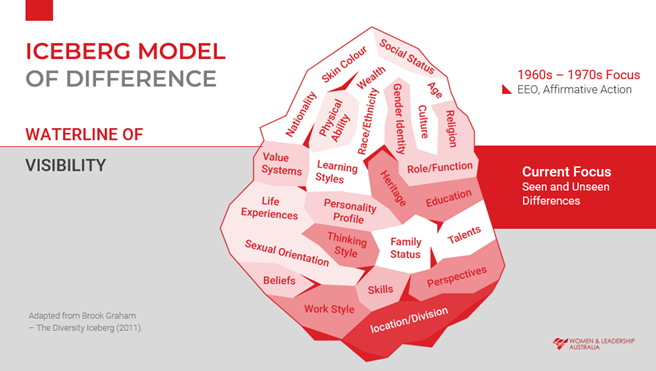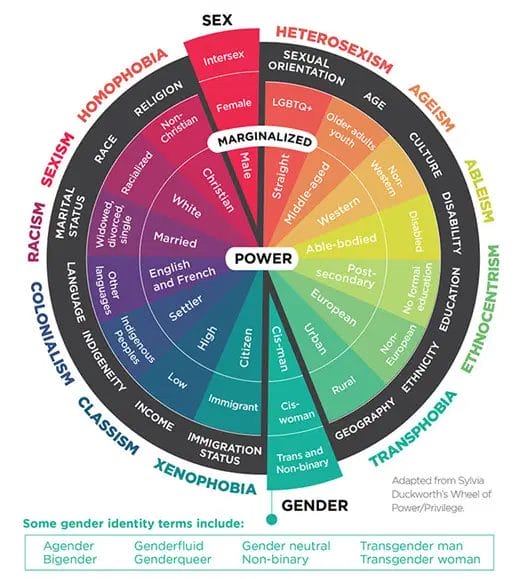Updated October 2024
Diversity Council Australia have released their updated Inclusion@Work Index 2023-2024 report. We’ve updated these stats below.
Inclusive leadership practices benefit everyone. Team performance and culture is improved, and staff have higher wellbeing, feel more motivated and engaged.
To celebrate #InclusionAtWorkWeek (Nov 18-22, 2024) we invite you to learn more about the areas of diversity, intersectionality, equity, power & privilege, and bias.
Not sure what Inclusive Leadership is? Read our blog on Inclusive Leadership to learn more.
Why Diversity, Equity and Inclusion matters for an organisation
The recent The 2023-2024 Inclusion@Work Index shows organisations taking D&I action outperform organisations that aren’t in a variety of performance and staff wellbeing measures.
The report shows that workers and inclusive teams are:
- 9.5 times more likely to be innovative than non-inclusive teams
- 8.5 times more likely to work effectively together
- 4 times more likely to provide excellent customer service
- 3 times less likely to leave their organisation
- 4 times less likely to experience discrimination and/or harassment
Sounds like the ideal workplace doesn’t it? So what areas need to be considered when looking to model an inclusive workplace?
Diversity needs to consider the whole person

This Iceberg of Differences model created by Brook Graham in 2011 conveys our evolved and current understandings of diversity.
In the 1960s and 70s, Diversity Training focused primarily on issues of race, gender, sexual identity and age with the introduction of laws requiring “Affirmative Action” – and training was considered one of the key elements of Affirmative Action programs. The focus during this time was primarily on visible differences, such as skin colour, age, gender identity.
However, in our current model of diversity, the whole person is now the focus of training, programs and activities under the umbrella of “Diversity. What’s ‘invisible’ such as life experience, personality traits and learning styles is now seen as just as important to identify in people.
What is the difference between equality and equity?

While these terms are often used interchangeably, equity and equality mean different things and lead to different results.
EQUALITY is treating everyone the same and giving everyone access to the same opportunities. For example, in Australia we have laws that prevent people being discriminated based on sex, starting with the landmark decision in 1969 that granted women equal pay.
But despite this, we do not have gender pay equity. Our national gender pay gap is currently 21.7% in 2024 and persists across all industries. Which means women on average earn 21.7% less than men.
EQUITY on the other hand is about acknowledging that people are different and helping everyone to achieve the same outcomes. In the workplace this means making adjustments or accommodations so everyone can do their best work. Another way of thinking about accommodations is that they are productivity enhancers, and help to create an inclusive culture in the workplace, some examples include:
- Providing a hearing loop system, or ramps for wheelchair access
- Providing quiet workspaces or noise cancelling headphones
- Providing safe spaces for breastfeeding in the workplace
- Allowances for different cultural holidays and observances
- Enabling flexible working arrangements
Understanding power, privilege, marginalisation, and intersectionality
“Intersectionality’ refers to the ways in which different aspects of a person’s identity can expose them to overlapping forms of discrimination and marginalisation.” Source: www.vic.gov.au/understanding-intersectionality

In managing people, leaders are in positions of power and have a responsibility to understand privilege and intersectionality as it relates to themselves and their team.
If a person has multiple realms of diversity, these overlapping aspects intersect, multiplying the negative impacts of discrimination and exclusion. This means that the experience of being a woman, for example, is not the same for all women, because of other impacting factors.
"As a purposeful and thoughtful leader, you need to appreciate the complexity of overlapping forms of discrimination, and meaningfully act in ways to challenge existing disparities" Kristen Howe https://www.linkageinc.com/leadership-insights/how-intersectionality-affects-the-advancement-of-women/
The Wheel of Power, Privilege, and Marginalization (Sylvia Duckworth, 2021) provides a helpful visual guide to better understand marginalisation and intersectionality. The further someone is from the centre ‘Power’ position the more marginalised they may be.
Consider, how privileged are you? Where do you sit on the wheel? What sort of marginalisation is your team experiencing?

Whilst you can’t change your position, (ie; your immigrant status is unchangeable, but your marital status might change) but by understanding and acknowledging your privilege you can begin to surface potential bias. Which in turn can help you as a leader to create an inclusive culture and enact policies to mitigate against bias.
What is Unconscious Bias?
Both conscious and unconscious influences decisions we make daily. Conscious bias refers to biased attitudes you may already be aware of. Whereas unconscious bias operates subconsciously due to societal and personal influences. Both conscious and unconscious bias can lead to discrimination against certain groups of people.
Surfacing unconscious bias is the first step leaders can take to reduce the likelihood of discrimination. One way to do this is to take one or more of the Implicit Association Tests. The Implicit Association Test was developed by scientists from Harvard, University of Virginia, and University of Washington, aims to educate the public about bias. The Implicit Association Tests, assesses conscious and unconscious preferences on various topics such as age, skin-tone, gender-career, weight, sexuality and more.
Some more actions you can take
- Make an effort to learn about the experiences of those not in your ‘in-group’ and other cultures
- Take an Implicit Association Test to test your own unconscious biases
- Invest in further learning about inclusive leadership for you or your staff – learn more about the Inclusive Leadership in Action program.
- Explore our blog on Why Inclusive Leadership Is the Essential Capability.
- Learn more about Diversity Council Australia’s #InclusionatWorkWeek

